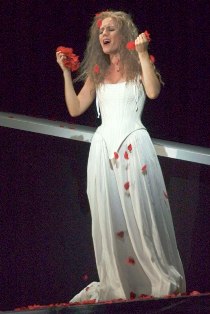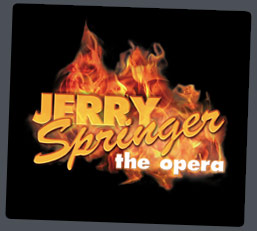
Lucie and Jerry
Lucie and Jerry. As different as can be, yet both are operas (dramas set to music).

“Lucie de Lammermoor,” the 1839 French version of Donizetti’s bel canto classic "Lucia di Lammermoor" about a Scottish lass who goes berserk on her wedding night and “Jerry Springer: The Opera” inspired by former Cincinnati mayor, television-news-anchor-turned-trash-TV icon, opened on the same night in Cincinnati, June 26, 2008.
“Lucie” played at Music Hall, the city’s aging Victorian grand dame on Elm Street in Over-the-Rhine. Presented by Cincinnati Opera, it was a gorgeous, pure-as-rainwater production starring a Lucie to die for, soprano Sarah Coburn.
“Jerry Springer” was given full foul-mouthed exposure by the alternative theater company, New Stage Collective, at its modest, rehabbed venue on Main Street on the opposite end of the historic, inner-city neighborhood..
Both were enthusiastically received -- if you don’t count the pickets from America Needs Fatima, who demonstrated against the blasphemy in "Jerry" outside the theater opening night. (According to NSC producing artistic director Alan Patrick Kenny, the show is being tested at smaller theaters in the U.S. before risking Broadway.)
Both operas were admirably true to their premises. "Lucie" is a lyric drama. Beautiful music beautifully sung (the meaning of bel canto), an end in itself.
"Jerry" is a satire in which the music takes on added meaning. There is beautiful music in this made-in-Britain work inspired by reality TV, but that is only part of the story.
First the beauty. (This reviewer heard the June 28 repeat of "Lucie de Lammermoor" and the June 27 performance of "Jerry Springer: The Opera.")
As staged, lit and choreographed by Cincinnati Opera -- scenery and costumes were created for Glimmerglass and Boston Lyric Opera -- "Lucie" seemed even more exquisitely French than the language difference itself would imply.
There was ballet, a parallel story told between the scenes of the opera, by a stag and a doe who pantomimed the love and death of Lucie and Edgard (exquisitely danced by Selahattin Erkan and Kristi Capps, with choreography by Devon Carney). Though minimal in construction -- upright, craggy panels set against a cloudy sky, with square, stylized lamps lowered over the stage for interior scenes -- the set was bathed in ravishing accent colors. Cincinnati Opera lighting designer Thomas Hase created the ever-present clouds, with reds, whites and golds splayed tellingly over the dark Scottish backgrounds.
The overall visual elegance was enhanced by the use of red rose petals for blood. Lucie's white wedding bouquet turned red after she signed the wedding contract with Arthur. By contrast, pale blue petals fell in abundance during Lucie's longing act I aria Que n'avons nous des ailes.
Soprano Coburn as Lucie was the most unreal of all: a tall, slender blonde with well-defined coloratura (including a spectacular high F in the act III mad scene), glossy tone color and knock-out good looks. She was a compelling actress also, a vision of distraction in the mad scene, where she laughed giddily, tossed rose petals in the chaplain Raymond's face and fantasized about Edgard while lying on her back on the stage.
Tenor Mark Panuccio was touching, even wrenching, as Edgard. His act I love duet with Lucie, where they exchanged rings, was as tender and well sung as any I can recall at Music Hall. Edgard's act III suicide, carried out with his shadow projected against a white panel, was grief stricken, subdued and showed some evidence of fatigue.
Baritone Getan Laperriere managed to project compassion as well as strength as Lucie's manipulative brother Henri. Tenor Jeremy Cady was a convincing "heavy" as Henri's accomplice Gilbert (ratcheted up in the French version). Tenor John McVeigh was a silver-voiced Arthur (Lucie's short-lived husband). Bass Alaine Coulumbe was solid and dark-voiced in the foreshortened role of Raymond. They, Coburn and Panuccio made made the act II sextet a thing of tenor-laced beauty. (Lucie's maid does not appear in the French version of the opera.)
Problems were few, mostly in terms of balance, as the Cincinnati Symphony led by Jean-Marie Zeitouni sometimes overpowered the singers (even the chorus in act I).
Then the Bad-Mouthed.

The libretto of "Jerry Springer: The Opera” contains four-letter
words. A lot of them, including all seven you can never say on TV according
to the late George Carlin -- and then some.
Cursing on stage is another matter, however, and in any case,
America Needs Fatima, whose members
picketed opening night June 26, did so more for religious than smutty reasons.
Hatched at the 2001 Edinburgh
Fringe Festival by composer/co-writer Richard Thomas and writer Stewart Lee, “Jerry Springer: The Opera” is an ingenious spoof, on both
musical and social levels. It opened at
NSC, located in a rehabbed building
at the corner of 12th and Main Streets in Over-the-Rhine, houses a small
100-seat theater on the second floor.
The cast of 25, including talented students from the
"Jerry Springer” is indeed an
opera, sung through, with only one major speaking role, that of Jerry himself,
robustly performed by Nick Rose (recently King Lear with
the Cincinnati Shakespeare Company). It is a hoot -- co-writer Lee is one of Britain's top stand-up comics -- with layers of deeper meaning about the media and its role in our world.
It may be a stretch, but there was an operatic genre called "verismo" in the late 19th-century that dealt for the first time with ordinary people as opposed to gods, goddesses, royalty and grand themes. Think "Cavalleria Rusticana" and "La Boheme." There's always the example of John Gay's "Beggar's Opera," too.
Act one, set in USA Studios,
Chicago, re-creates a typical “Jerry Springer Show,” with the members of the
ensemble occupying the front row of seats as ringleaders of the vociferous studio
audience. The Warm-Up Man (Michael Shawn
Starks of
“Guests” on the show include a man
who confesses to cheating on his fiancée, both with her best friend and a male transvestite;
a man who strips to a diaper and begs to be his girlfriend’s “baby"; and Baby
Jane, an abused adult baby who becomes Jerry’s advocate in act III (Hell). Also, a fat lady who dreams of being a pole
dancer, her redneck husband and cross-toting mother and finally, an ensemble of
tap-dancing Ku Klux Klansmen (watch the wicked images on TV monitors set up in
the theater for simultaneous commentary).
At the end, Jerry fires his Warm-Up Man for incompetence, who in turn, goads the
diaper fetishist to shoot Jerry, who asks “Why did I get shot?”
Part two continues in Purgatory, then Hell, where Jerry is met by the Warm-Up Man, now Satan, who orders him to
host a show in Hell. Satan’s object is
to persuade God to apologize for casting him out of Heaven. “Guests” are Jesus (in loincloth and gold
glitter), Mary, Adam and Eve, who bicker over mutual slights. “Where were you?”
(“when I was on the cross”) sings Jesus.
Ultimately, God (William Reed of CCM)
appears in a white suit, singing “It Ain’t Easy Bein’ Me” (“and taking the
blame for everything”), country-western style.
The most side-splitting moment in the opera occurred when Jesus (Jesse Draud of CCM) and Satan (Starks) sang a ravishingly beautiful duet on “F---,” spinning
agile coloratura on the long-held syllable before coming down on the expected "Y--" at the end.
Like all opera, the depth in “Jerry
Springer” resides in the music, which is always closely matched to – and
sometimes “too good” for – the tawdry text.
There are choruses right out of Bach and Handel (“Please let me be on
TV”), Lloyd-Webber moments (Satan’s mocking aria “Every last m----- f-----
should go down” recalls “Jesus Christ Superstar”). Broadway, gospel, pop (“I
Just Wanna’ Dance”), rock -- you name it. Wagner aficionados recognized Jerry’s “inner
Valkerie,” a character in horns and helmet who goads him once or twice early
on.
It all resolves in a kind of
apotheosis of Jerry Springer. As he and
they realize, Jerry’s guests seek what
everyone seeks, to be loved, to be important and to be noticed, if only “for a
Jerry Springer moment."
“You are there for us, Jerry,” the
chorus sings. “Jerry eleison."
The show repeats at 8 p.m. July
3-5, 10-12, 17-19, 24-26, 31 and August 1-2, 3 p.m. July 6, 13, 20, 27 and
August 3. Tickets are $20, $16 for
seniors and $12 for students. Order
online at www.newstagecollective.com
or call (513) 621-3700.